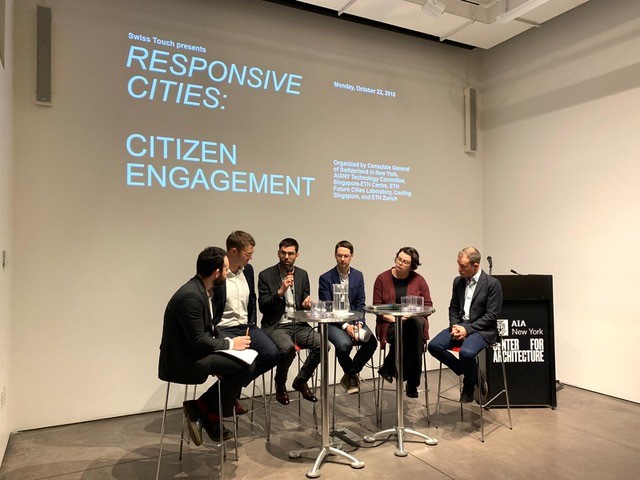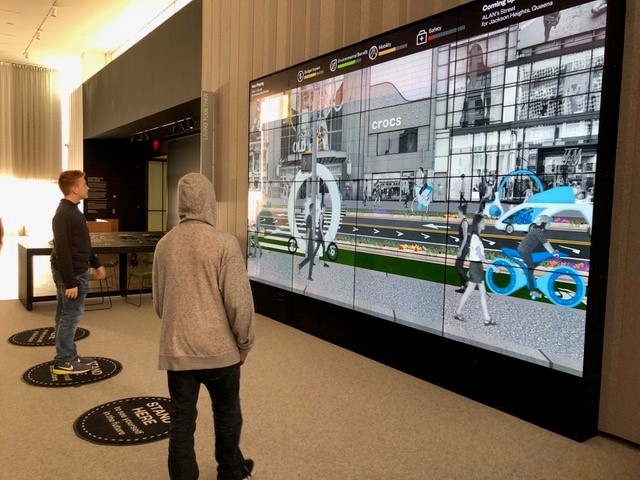Archtober is a month-long celebration of architecture and design taking place annually in New York City. Organized by the Center for Architecture, the 2018 instalment of Archtober gathered events ranging from daily building tours and lectures by design experts, to architecture-themed competitions and workshops. In the frame of Archtober 2018, the Swiss Consulate in New York City organized two events about Citizen Engagement and Urban Heat. We were very grateful to the Swiss Consulate in New York City and ETH Global for supporting the participation to these two events with four researchers working at the Singapore ETH Centre-Future Cities Laboratory: Lea A. Ruefenacht, Heiko Aydt, Panos Mavros and Fabien Clavier. This was a great opportunity to showcase our work and interact with like-minded speakers in New York City.
Informing Cities from the Ground up
by Fabien Clavier and Panos Mavros, 06.12.2018

Panel discussion on Citizen Engagement at the Center for Architecture, October 2018 (photo credit: Swiss Consulate in New York City)
On the occasion of Archtober 2018, New York City’s Architecture and Design Month, a group of researchers from the Singapore ETH Centre - Future Cities Laboratory travelled across time zones to share insights about new ways of engaging citizens in urban design and learn about their American counterparts.

Citizen engagement platform at the Future City Lab - Museum of the City of New York, Oct 2018 (photo credit: Fabien Clavier/ETH Zurich)
Citizen engagement
Cities are more and more infused with data and technology, opening up exciting perspectives to inform urban planning and design decisions. But what about the people? How can data-informed approaches empower people and improve human-centric design, as well as modify the relationship between governments and citizens?
Reflecting on their discussion with the invited experts and audience in New York City, Fabien and Panos derived three steps to leverage data for more human-friendly cities:
LISTEN
People around the world are sharing more and more data about their experience of the city, through social media, interactive participation platforms, or voluntary projects. Social listening has become a tremendous opportunity for decision-makers to better grasp people’s aspirations and lifestyles. For example, Rosamund Fletcher from the Design Trust for Public Spaces, explained how she conducted participatory workshops throughout in New York City to solicit input and feedback from the community, in order to reclaim public spaces below transit infrastructures. At the Future Cities Laboratory, researchers from the Big Data module gauge the impact of cultural planning initiatives and people’s appreciation of art spaces by analysing the ‘footprints’ of social media. Researchers from the Cognition Perception and Behaviour module invite volunteers to participate in behavioural experiments, in order to understand wayfinding and subjective experience of moving through the busy, bustling and multilevel metropolis.
ENGAGE
As we uncovered during the discussion, the use of data should not be only to confirm pre-defined policies but also to explore new directions. The power of data comes fully when we let people ask the questions rather than when we merely seek their validation on well-thought-out plans. For that, we need attractive and out-of-the-box tools. We were very impressed by the Museum of the City of New York’s Future City Lab, an interactive game that encourages visitors to step into the shoes of an urban planner and make design proposals for a specific site. It reminded us about the tools being developed and tested at the Future Cities Laboratory, as in a recent crowdsourcing public campaign for a new development in Singapore, Waterfront Tanjong Pagar.
ACT
Finally, we need to bridge the gap between people’s knowledge and experts’ knowledge. This is the tricky part, as the path from data collection to decision-making is paved with many challenges. For that we need open-source and contributive platforms to clarify how the use of data has led to specific decisions and what were the trade-offs. Data should help to shape best practices and avoid repeating known mistakes. For example, Mike Aziz shared how the Project NY initiative is leading efforts to break data-silos and create a platform that gathers urban data across organisations and makes visualisations available to citizens and stakeholders alike. Such approaches are necessary to increase the engagement with informed and evidence-based design.
What the transformative research conducted at ETH’s Future Cities Laboratory and similar efforts worldwide show is that in order to address urban challenges and shape city futures, citizens, stakeholders and researchers should strategically utilise all these three approaches of engagement: listening and engaging with citizens and using data to identify shared action-plans.
About the authors

Fabien Clavier is Project Coordinator for the Big Data Informed Urban Design and Governance group at the Future Cities Laboratory – Singapore ETH Centre. He is an urban planner with experience in master-planning, smart cities and urban governance projects. Fabien is interested in new forms of urban governance and how urban stakeholders can benefit from Big data-derived methods to increase transparency, accountability, and equal voice in urban planning.
Panos Mavros is a Project Coordinator of Cognition, Perception and Behaviour in Urban Environments at the Future Cities Laboratory (FCL) of the Singapore-ETH Centre. He is trained as an architect and during his doctoral studies at University College London he specialised in navigation, psychophysiological methods and spatial analysis. Panos' research focus is understanding the interaction between the design of buildings and urban spaces with the behaviour and experience of people.

